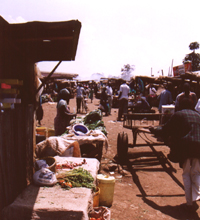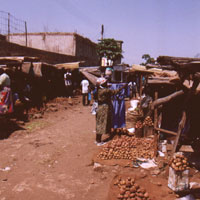|
The farmers grow a variety of crops but two only are grown for commercial purposes - sugar and tobacco. The market for both is unpromising. The sugar industry has almost collapsed and the tobacco market, dominated by international companies like British American Tobacco, has falling demand. One tobacco farmer I visited had just stopped his contract with BAT since he can no longer make a profit from the price they pay him for his crop. Despite sugar being widely available in the area, it is still imported from nearby countries like Sudan. Fruits like mangoes are available almost everywhere, yet mango fruit juice is imported from South Africa. Buying local produce is not the norm, apart from the poor people who cannot afford imported or nationally-produced goods.
In addition to peanuts, people also grow maize, beans and pineapples that can sometimes grow in sufficient quantities to be marketable. Although other fruits and vegetables are grown, they are rarely harvested in sufficient quantities for them to be sold. It's only in good harvests that some people have a surplus to sell. Sadly, that's also the time when prices are lowest. Some stock piling is done, e.g. maize, but it needs to be picked at the right time to ensure weevils don't attack it in store. Daily life is tough for most people. Three-quarters of the population are involved in agriculture in some way. Most are self-employed. Many of the men will also seek casual employment in nearby towns whilst the women and children look after the animals and manage the farm as well as looking after the family needs. That often involves spending many hours every day collecting water and searching for firewood. Over 95% of the population has no access to grid electricity. A very small proportion are beginning to benefit from micro-hydro electricity schemes but outside Nairobi and the other large towns, most people rely on kerosene for lighting and wood-fires for cooking and heat. Poor health is widespread. Most people live from day to day. They make whatever they can from whatever they can sell.
Some might collect water in jerry cans on a hand cart or bicycle and sell it to others. (They will collect
it from either pipeline water points or rivers.) Some make charcoal and sell it at the roadside. Some sell
fruit or fish at the roadside. They eke out whatever they can. It will often be only a few shillings (100
Kenyan shillings = £1 approx), which means they only have a few shillings to spend on the daily
necessities. When they have a crisis, they may sell an animal or any surplus they have put aside. It may be
a health problem, or they want to send another child to school, or they need a new part for a machine.
|
 Kisumu
is a large town in the west of Kenya, six hours drive by car
from Nairobi, only 50 minutes by plane. Migori is a further
three hours drive but both towns are close to the border with
both Tanzania and Uganda, and are close to Lake Victoria.
Migori is smaller but can be used as an example of typical
life in western Kenya.
Kisumu
is a large town in the west of Kenya, six hours drive by car
from Nairobi, only 50 minutes by plane. Migori is a further
three hours drive but both towns are close to the border with
both Tanzania and Uganda, and are close to Lake Victoria.
Migori is smaller but can be used as an example of typical
life in western Kenya.  Peanuts are widely grown for use in the home as an ingredient in soup, porridge, puddings
and cakes. They can also be turned into a powder to feed small children. Recently they have been seen as a
way of making a small enterprise income by using a peanut milling machine. (For more details, see Money for
Peanuts, available from ITDG, which will soon become a case study on the STEP website, accessible through
Peanuts are widely grown for use in the home as an ingredient in soup, porridge, puddings
and cakes. They can also be turned into a powder to feed small children. Recently they have been seen as a
way of making a small enterprise income by using a peanut milling machine. (For more details, see Money for
Peanuts, available from ITDG, which will soon become a case study on the STEP website, accessible through